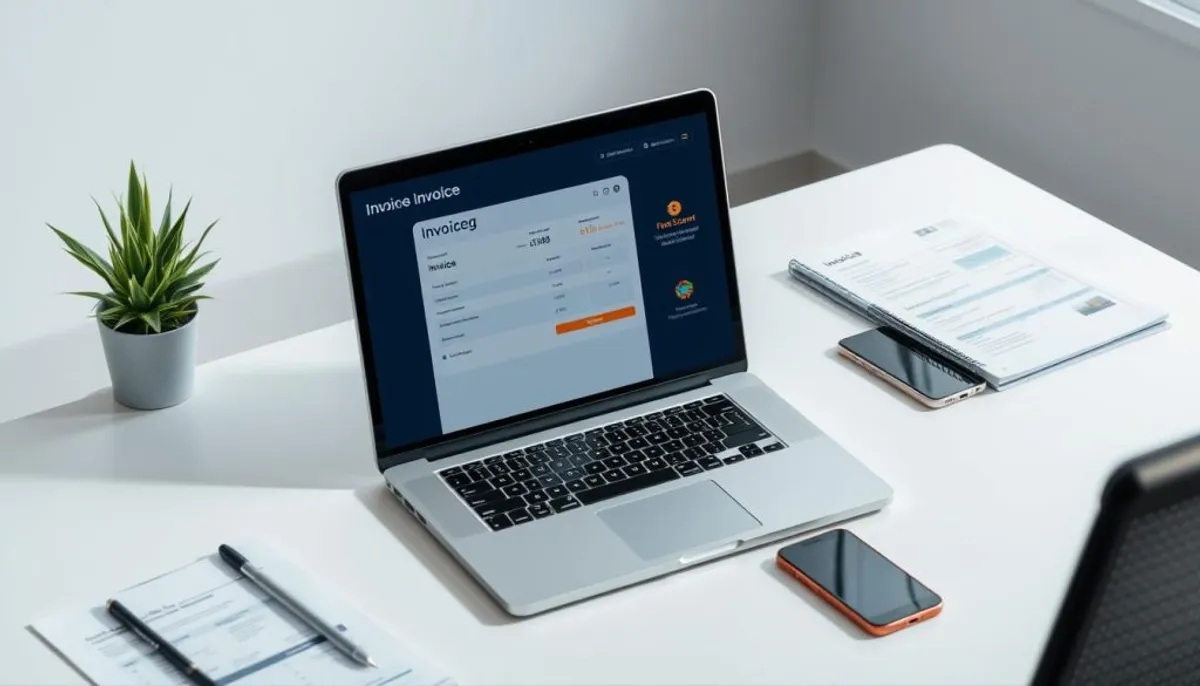Creating clear and professional invoices is crucial for effective invoice management and preventing unpaid invoices. A well-crafted invoice not only streamlines your accounts receivable process but also enhances your business’s image. Let’s explore some essential tips to help you create invoices that prompt timely payments and maintain a healthy cash flow.

Effective invoicing starts with understanding its impact on your business. Studies show that clear and concise invoices result in faster payments compared to confusing ones. In fact, businesses using online invoicing solutions witness a 25% decrease in payment processing time. By implementing these tips, you’ll be on your way to improving your invoicing process and reducing payment delays.
Remember, your invoice is often the last interaction you have with a client for a project or sale. Make it count by ensuring it’s professional, clear, and easy to understand. This approach not only facilitates prompt payments but also leaves a positive lasting impression on your clients.
Key Takeaways
- Clear invoices lead to faster payments and improved cash flow
- Online invoicing solutions can decrease payment processing time by 25%
- Professional invoices enhance your business image and client relationships
- Effective invoice management prevents unpaid invoices
- Automated reminders can significantly reduce late payments
- Multiple payment options can increase timely payments by 15%
- E-invoicing can reduce errors by 40% and increase customer satisfaction by 50%
Understanding the Importance of Professional Invoices
Professional invoices are the cornerstone of successful business transactions. They are vital for Cash Flow Management and in maintaining robust client relationships. Exploring the significance of well-crafted invoices is crucial for your business’s success.
The role of invoices in business transactions
Invoices act as legal documents, receipts, and payment requests. They detail the goods or services rendered and the amount owed. In the US, small and medium-sized businesses spend at least 15 days annually on late payment pursuits. This underscores the importance of effective invoicing practices.
How professional invoices impact cash flow
Professional invoices are essential for managing cash flow. They facilitate the tracking of accounts receivable and ensure timely payments. Unpaid invoices can pose significant financial risks and hinder operational efficiency. Implementing Late Payment Fees can prompt timely payments, enhancing cash flow.
| Invoice Age | Payment Likelihood |
|---|---|
| 0-30 days | High |
| 31-60 days | Moderate |
| 61-90 days | Low |
| 90+ days | 60% less likely to be paid |
Building trust with clients through clear invoicing
Clear and accurate invoices prevent misunderstandings and disputes. Effective Customer Communication Strategies, like personalized follow-ups and payment plans, strengthen client relationships. Subject lines under 50 characters boost invoice email open rates by 12%.
By focusing on professional invoicing, businesses can streamline financial processes, enhance cash flow, and build stronger client bonds. Investing in quality invoicing software and setting clear payment terms are pivotal steps towards these objectives.
Essential Elements of a Well-Structured Invoice
A meticulously crafted invoice is vital for effective Invoice Management. It acts as a formal transaction record, crucial for maintaining a healthy cash flow. By adhering to Invoicing Best Practices, businesses can facilitate timely payments and foster trust with clients.
An effective invoice must contain:
- Company information and logo
- Customer details
- Unique invoice number
- Issue date and due date
- Detailed service or product description
- Quantity and unit price
- Total amount due
- Payment terms and accepted methods
Clear and precise invoices expedite payments and diminish confusion. They also function as legal documents for tax purposes. By including all pertinent information, businesses can streamline their Invoice Management processes and enhance overall efficiency.
Remember, a professional invoice reflects your brand image. It transcends mere payment requests; it’s a chance to underscore your dedication to quality and customer service. Embracing these Invoicing Best Practices can foster better client relationships and a more robust bottom line.
Designing a Professional Invoice Layout
Creating a professional invoice layout is crucial for clarity and making a strong impression. Online Invoicing Software aids in designing invoices that are visually appealing and functional. Let’s dive into the process of crafting an ideal invoice layout.
Choosing the right template
Select a template that aligns with your business’s needs. An effective template should include your business name, contact information, client details, invoice number, due date, service specifics, and payment terms. Utilize Invoice Management tools to discover templates that enhance your invoices’ visual appeal.
Incorporating your brand elements
Your invoice should mirror your brand’s identity. Incorporate your logo, brand colors, and maintain consistent font usage. This approach fosters client recognition and trust. Many Online Invoicing Software platforms offer customization options for templates, allowing you to integrate your brand elements seamlessly.
Balancing aesthetics and functionality
Ensure your invoice is visually appealing while maintaining readability. Employ white space to demarcate sections effectively. Emphasize critical information such as the total amount and due date. A well-organized layout facilitates quick navigation for clients.
| Invoice Element | Purpose | Best Practice |
|---|---|---|
| Business Name | Identification | Place at the top, use larger font |
| Invoice Number | Organization | Use unique, sequential numbers |
| Due Date | Payment Timeline | Make it bold and visible |
| Service Details | Clarity | Use clear, concise descriptions |
| Total Amount | Payment Clarity | Highlight with larger font or color |
A well-designed invoice can expedite payment processing and enhance your cash flow. Leverage Invoice Management features to streamline payment tracking and follow-up processes.
Clear and Concise Service Descriptions
Clear service descriptions are crucial for effective invoicing. They prevent misunderstandings and disputes, which account for nearly 50% of unpaid invoices. By detailing goods or services, quantities, and unit prices, trust with clients is built, and the payment process is streamlined.
Implementing invoicing best practices can significantly improve outcomes. Studies reveal that clear, detailed invoices can reduce payment delays by up to 25%. This transparency enhances customer communication strategies and boosts your business’s credibility.
To create effective service descriptions:
- Use simple, jargon-free language
- Break down complex services into understandable components
- Include specific dates, hours, or quantities
- Align descriptions with your initial quote or contract
Remember, clarity in your invoices fosters better customer relationships. Research shows that consistent and timely invoicing can decrease payment delays and disputes by 23% in the service industry. By prioritizing clear communication, you’re not just enhancing your invoicing process. You’re also strengthening your entire business operation.
Preventing Unpaid Invoices through Efficient Invoicing
Unpaid invoices can severely disrupt your business’s cash flow. In the US, 49% of invoices issued by businesses become overdue. To combat this, it’s essential to adopt efficient invoicing practices. This approach helps prevent unpaid invoices and ensures a healthy accounts receivable.
Setting Clear Payment Terms
It’s vital to set clear payment terms from the outset to avoid misunderstandings. Clearly define due dates and outline penalties for late payments. Offering a 1-2% discount for early payment within 10 days can incentivize clients to pay on time. This approach can notably decrease the number of overdue invoices.
Implementing Late Payment Fees
Introducing late payment fees can prompt clients to pay on time. It’s important to be aware of the legal limits on interest charges, which differ by state in the US. In the UK, the government provides guidelines on late payments. Clearly communicate your late payment policy on invoices to ensure clients understand the repercussions of delayed payments.
Offering Multiple Payment Options
Providing diverse payment methods can expedite the payment process. Research indicates that 40% of customers delay payment if the process is complex. Offer payment options like credit cards, ACH transfers, and online platforms. Include detailed instructions for each payment method on your invoice to simplify the process.
| Payment Method | Advantages | Considerations |
|---|---|---|
| Credit Card | Fast processing, widely accepted | Transaction fees |
| ACH Transfer | Low fees, secure | May take several days to process |
| Online Platforms | Convenient, immediate | Platform fees may apply |
By adopting these strategies, you can significantly reduce the risk of unpaid invoices and enhance your business’s financial health. Efficient invoicing practices are crucial for maintaining a steady cash flow and building strong client relationships.
Leveraging Technology for Invoice Management
Modern businesses are embracing technology to streamline their invoice management processes. Online invoicing software and automated billing systems are revolutionizing the way companies handle their finances. These tools are beneficial for businesses of all sizes.
Online Invoicing Software Options
Online invoicing software offers unparalleled accessibility, user-friendly interfaces, and instant updates on invoice status. Tools like Zoho Invoice and FreshBooks enable businesses to generate professional invoices swiftly and effectively.

Automated Billing Systems
Automated billing systems dramatically cut down processing time and errors. Manual invoicing takes an average of 10.1 days, whereas automated systems manage it in just 3.9 days. This efficiency enables companies to capitalize on early payment discounts and sidestep late fees.
Integration with Accounting Software
Integrating invoice management tools with accounting software streamlines workflows. This integration simplifies approval processes and ensures timely payments. Companies can potentially save up to 80% in processing costs through automation.
| Process | Manual | Automated |
|---|---|---|
| Processing Time | 10.1 days | 3.9 days |
| Invoices Processed Per Hour | 5 | 25+ |
| Cost Per Invoice | $2.07 – $10.00 | $0.41 – $2.00 |
By adopting technology for invoice management, businesses can enhance efficiency, minimize errors, and improve cash flow. The transition from manual to automated processes is essential for modernizing financial operations.
Effective Communication Strategies for Invoicing
Clear communication is paramount for effective invoice management. With 50% of design agency invoices paid up to 60 days late, adopting robust customer communication strategies is essential. Agencies invest nearly 13 hours weekly in chasing late payments, underscoring the necessity for enhanced invoice management practices.
Personalize your invoices and employ clear language to prevent misunderstandings. Offer detailed charge breakdowns, facilitating clients’ comprehension of their payments. Such transparency fosters trust and minimizes payment delays.
Establish a system for consistent follow-ups and reminders. Payment terms vary by region – 30 days in the UK, 14 days in some EU countries, and up to 60 days in the U.S. Customize your communication approach to these standards while maintaining a professional yet friendly demeanor.
Consider implementing the following strategies:
- Use automated reminders for upcoming and overdue payments
- Offer multiple payment options to accommodate client preferences
- Clearly state payment terms and late fees on every invoice
- Provide incentives for early payments
By embracing these customer communication strategies and leveraging technology for invoice management, you can substantially reduce payment delays and enhance your cash flow.
Best Practices for Invoice Follow-up and Reminders
Effective invoice follow-up and reminders are vital for maintaining a healthy cash flow. Implementing smart strategies can significantly boost payment rates and alleviate the stress of chasing unpaid invoices. This approach is essential for the financial health of any business.
Setting up automated reminders
Automated billing systems can greatly streamline your accounts receivable process. Establish a routine follow-up schedule, sending friendly reminders a few days before the due date. Follow up promptly if payment is not received. This consistent method helps manage client expectations and ensures steady cash flow.
Personalizing follow-up messages
While automation is beneficial, personalizing your payment reminders can enhance their effectiveness. Start with a friendly first reminder, then a firmer second notice. Finish with a final reminder outlining potential consequences for non-payment. This balanced approach encourages prompt responses from clients, blending professionalism with a personal touch.
Escalation procedures for overdue accounts
For significantly overdue or high-value invoices, a clear escalation procedure is crucial. This might include additional reminders, phone calls, or involving a collections agency as a last resort. Always consider the statute of limitations for debt collection in your area when planning your strategy. Prioritizing follow-up efforts on these accounts can have a substantial impact on your business finances.
RelatedRelated articles



